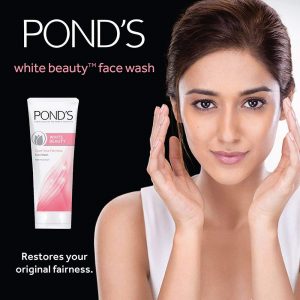GRSJ 30099C Culture Jam Assignment
Colourism in the Beauty Industry

“Pond’s White Beauty Face Wash”
In the world of consumer capitalism, marketing companies work relentlessly to sell their products to consumers, regardless of what type of message is being conveyed in the mass media. Often, these branding techniques cater towards the ideal, normative market that all demographics aspire to become. Culture jammers work to dismantle the messages of global capitalism by “turn[ing] the commercial techniques and emotion” back onto the creators (Warner 2007), by duplicating the same advertisement and replacing the original message with a blatant mockery of what the company is truly representing.
The advertisement I chose to deconstruct is a Pond’s commercial advertising their “White Beauty” line of skincare, which is a bestseller in South Asia. This stems from the caste culture in South Asia which ranks those with the fairest skin as upper caste, and those with darker skin as lower caste. Sureshi M. Jayawardene interprets this as a deep-rooted issue stemming from “the lens of race and racial ideas developing in European thought” during the era of colonization (2016), where Eurocentric thought plagued India and left behind unrealistic ideals that Indians still bear the burden of today.
Ponds, along with other skin whitening companies including Fair and Lovely, operate based on the age-old belief in India that lighter skin is superior to darker complexions. The ad showcases a very fair Indian woman with bright eyes and light hair, alongside the caption “Restores your original fairness”. The campaign promotes the message that everyone has “fairness” within them, and using skin lightening and bleaching products will eradicate the dirt that -according to these companies and this culture- accompanies darker complexions. The use of the word “restore” implies that darker skin is something that requires repairing, which can only be done with the use of Pond’s “White Beauty” products. Naming a product “White Beauty” is a blatantly obvious example of fairness and beauty being synonymous, which manifests itself deeply into the minds of darker women, leading them to believe that their darker skin makes them unappealing and unworthy.

“Pond’s Colourism Culture Face Wash” (Jammed)
In my culturally jammed version of the Pond’s ad, I chose to replace the words “White Beauty” with “colourism culture”, because I believe by purchasing skin lightening products, consumers are restoring and reaffirming their belief in the culture of colourism and submitting themselves to the idea that lighter skin is desirable and darker skin deserves discrimination.
Colourism culture and skin lightening are interwoven into various systems around the world including multi-billion dollar industries and even black markets that sell unregulated skin bleaching products (Glenn 2008). In India specifically, there is a wide range of skin colour from northern to southern states, and despite this large variety in complexions, India continues to be the “largest market for skin lighteners” because women of all ages are targeted to “Reclaim” their youthful skin colour, as though aging and getting darker are interchangeable (Glenn 2008). The real ad uses similar language, and claims that using this whitening face wash will “restore” original fairness, thus creating a false promise and implying that it is indeed true that all Indian women start off fair and simply get darker over time. By keeping the word “restore” and changing the rest to “beliefs in the caste system”, I hope to invoke a sense of complacency in the targeted audience.
This should transform the idea of fairness being the only type of beauty into the realization that purchasing these products, they are contributing to the concepts of the caste system and upholding the belief that darker complexions are beneath lightness, thus making them undesirable. By jamming the original message, the true idea is exposed through the subtle “process of intervention” without a drastic change in the actual advertisement. The consumer is still seeing the same product, and the message is simply an “amping up” of the truth (Harold 2007). The targeted audience is forced to think critically about the market they are contributing to, and whether or not they want to continue promoting these unrealistic dominant ideologies that validate discrimination towards darker skinned people.
Sources
Glenn, Evelyn N. “YEARNING FOR LIGHTNESS: Transnational Circuits in the Marketing and Consumption of Skin Lighteners.” Gender and Society, vol. 22, no. 3, 2008, pp. 281-302.
Harold, Christine. “Pranking Rhetoric: “Culture Jamming” as Media Activism.” Critical Studies in Media Communication, vol. 21, no. 3, 2004, pp. 189.
Jayawardene, Sureshi M. “Racialized Casteism: Exposing the Relationship between Race, Caste, and Colorism through the Experiences of Africana People in India and Sri Lanka.”Journal of African American Studies, vol. 20, no. 3, 2016, pp. 323-345.
Warner, Jamie. “Political Culture Jamming: The Dissident Humor of “the Daily show with Jon Stewart”.” Popular Communication, vol. 5, no. 1, 2007, pp. 17.